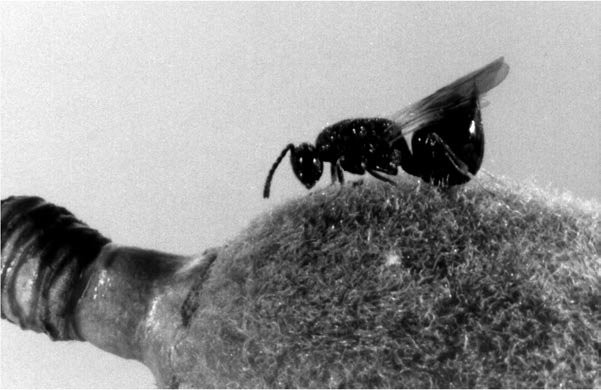Almond Seed Wasp, Eurytoma amygdali Enderlein
The almond seed wasp is a serious pest of almonds, Prunus amygdalus Batch, in several countries of southeastern Europe and the Middle East, and also in Armenia, Azerbaijan, and Georgia. The adult female is
Almond seed wasp is a univoltine species, with a small part of the population completing its life cycle in two or more years because of prolonged diapause. The diapause terminates during the winter. Pupation takes place inside the fruit in late winter to early spring. Adults emerge aſter boring a circular exit hole through the hard pericarp with their mandibles. Shortly aſter adult emergence, virgin females release a volatile sex pheromone to attract males for mating. Within a few days they mate and the females start ovipositing into unripe, green almonds. Using her long ovipositor, the female drills through the pericarp of unripe, green almonds and the integument of the seed, and deposits a stalked egg within the translucent nucellar tissue. Aſter oviposition, the female deposits onto the fruit surface a host-marking pheromone. This pheromone enables females to discriminate between the infested and uninfested fruit, and to select the latter for oviposition. Thus, a uniform distribution of eggs among available fruits is achieved, and an optimal use of the available fruit for larval development. The newly hatched larva bores through the nucellus and the embryo sac to feed on the developing seed embryo. The larva attains full size in midsummer, and enters diapause within the seed integument of the destroyed almond, which usually remains on the tree in a mummified condition.
Owing to oviposition by the wasp certain varieties suffer a heavy premature drop. In most varieties though, the main damage consists in the consumption of the seed by the larvae. This damage varies depending on the variety. Certain soft-shelled varieties may lose up to 90% of their crop. Others are nearly immune because by the time females emerge in spring their pericarp has become too thick and endocarp too hard for the ovipositor to penetrate. Though not a common practice, planting of resistant varieties might be an effective strategy against this pest.
The pest can be controlled by collection and destruction of mummified fruits before adult emergence in spring, which is an effective measure if applied in large areas by multiple growers. However, the method most commonly used is the application of systemic insecticides against the neonate larvae within the oviposited almonds. This strategy is meant for varieties that do not suffer fruit drop because of oviposition. Recent studies have indicated that a single spraying can be effective if applied when

Female Eurytoma amygdali ovipositing into an almond

Allelochemicals


